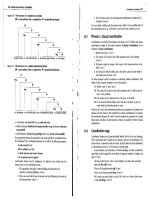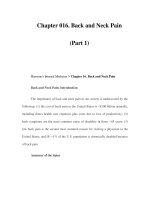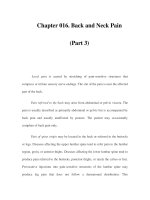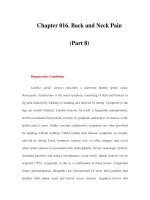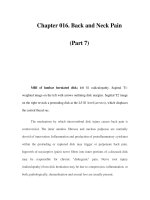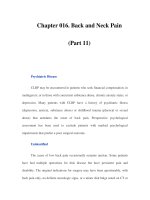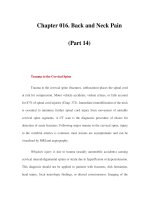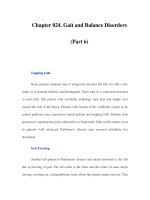Chapter 116. Immunization Principles and Vaccine Use (Part 11) ppsx
Bạn đang xem bản rút gọn của tài liệu. Xem và tải ngay bản đầy đủ của tài liệu tại đây (12.22 KB, 5 trang )
Chapter 116. Immunization Principles
and Vaccine Use
(Part 11)
Current Controversies
Even though vaccines are very safe and serious adverse events proven to be
due to licensed vaccines are rare, the recent rise in the reporting of autism
spectrum disorders has led some parents of affected children to claim that
thimerosal—used as a preservative—is the cause of the problem. No study has yet
implicated thimerosal or the vaccines in which it has been used as a likely cause of
these disorders; however, fully 50% of cases before the Vaccine Injury
Compensation Program concern autism allegedly due to mercury. In 1999,
thimerosal was removed from single-dose formulations of recommended
childhood vaccines in the United States; the exception is influenza vaccine, for
which thimerosal-free preparations have been in short supply. There is no
evidence that the frequency of autism diagnoses has changed since the
discontinuation of thimerosal use, but further observation is necessary. It is
important to resolve these controversies, particularly because it may be difficult to
ensure product sterility in developing countries—where multidose vials of vaccine
are most cost-effective—without the use of preservative.
Disparities in vaccine coverage among the majority and minority
communities in the United States persist. Reasons for underimmunization include
limited access to health care, lack of insurance, assignment of a low priority to
preventive measures, and insufficient knowledge about vaccines and the
importance of being vaccinated. The persistence of wild poliovirus in
immunocompromised individuals and the reversion of live poliovirus vaccine to
virulence in several communities have catalyzed debate about whether it really is
possible to eradicate poliovirus from the world (thus allowing the cessation of
immunization) or whether the best that can be hoped for is the worldwide
elimination of clinical disease, with continued routine immunization to keep the
risk low.
The addition of new, individually injectable vaccines to the childhood
immunization schedule has heightened parental concerns about multiple injections
at a single clinic visit. The continued development and testing of vaccine
combinations aim to mitigate these concerns. Even when multiple injections are
required, providers must make every effort to administer all indicated vaccines at
each visit.
Delivery of Vaccines
Over the past 25 years, considerable progress has been made to ensure that
every child in the United States is fully immunized by the time of school entry. All
50 states now require immunization for school entry, and most have laws
addressing attendance at preschools and day-care centers. Despite the dramatic
impact of immunization and of other improvements in health care on the incidence
of vaccine-preventable illness in the United States, many children still are not fully
immunized, both in poor communities with inadequate health services and in
affluent communities where parental concern about potential adverse events may
exceed concern about now-uncommon diseases. The failure to vaccinate preschool
children was largely responsible for the resurgence of measles in the United States
in 1989–1991, with >55,000 cases and >130 measles-related deaths. Outbreaks of
pertussis, mumps, and congenital rubella syndrome have occurred wherever
immunization rates among preschool children are low. While indigenous
transmission of polio, measles, and rubella has been eliminated in the United
States, the risk of imported infection and spread to vaccine-naïve susceptible
persons persists.
Access to Immunization
Four major barriers to infant and childhood immunization have been
identified within the health care system: (1) low public awareness and lack of
public demand for immunization, (2) inadequate access to immunization services,
(3) missed opportunities to administer vaccines, and (4) inadequate resources for
public health and preventive programs. National outreach and educational
campaigns promote parental awareness of the value of vaccination and encourage
health care providers to use every opportunity to vaccinate the children in their
care.
Handling of Vaccines
Vaccines must be handled and stored with care. Attention to the entire
"cold chain"—from storage, shelf life, reconstitution, and shelf life after
reconstitution and opening—is essential to ensuring that clients receive potent
vaccines. Vaccines should be kept at 2°–8°C and, with the exception of varicella
vaccine and live attenuated influenza vaccine, should not be frozen. The latter two
vaccines should be kept frozen at –15°C. Measles vaccine must be protected from
light, which inactivates the virus.
Standards for Immunization Practice
National standards of immunization for childhood, adolescent, and adult
practice have been established to define common policies and practices for public
health clinics and physicians' private offices (Table 116-4). These standards
represent the most desirable immunization practices and highlight the need to
distinguish between valid contraindications and conditions that are often
considered to be but are not in fact contraindications
(www.cdc.gov/vaccines/recs/vac-admin/downloads/contraindications_guide.pdf).
